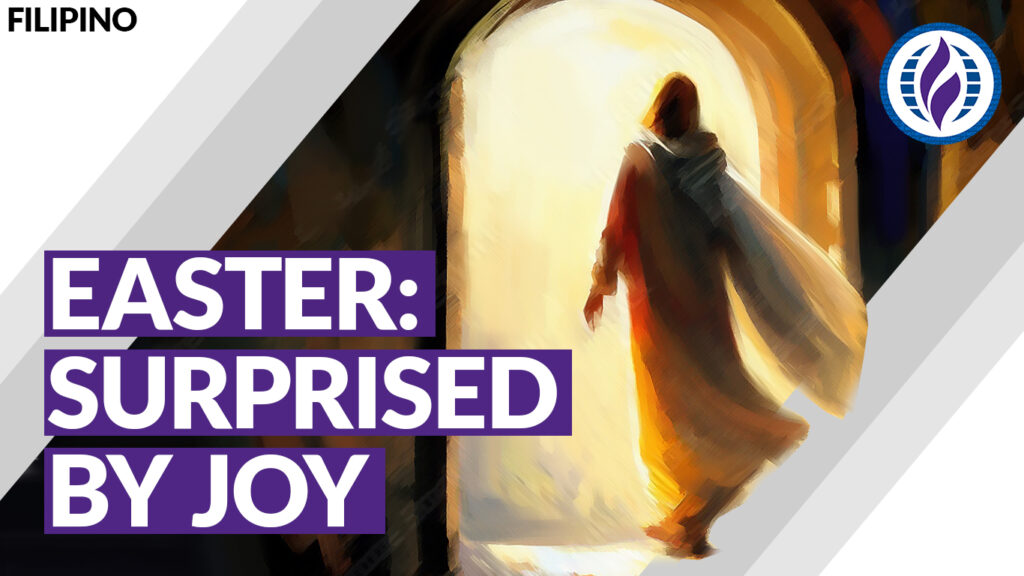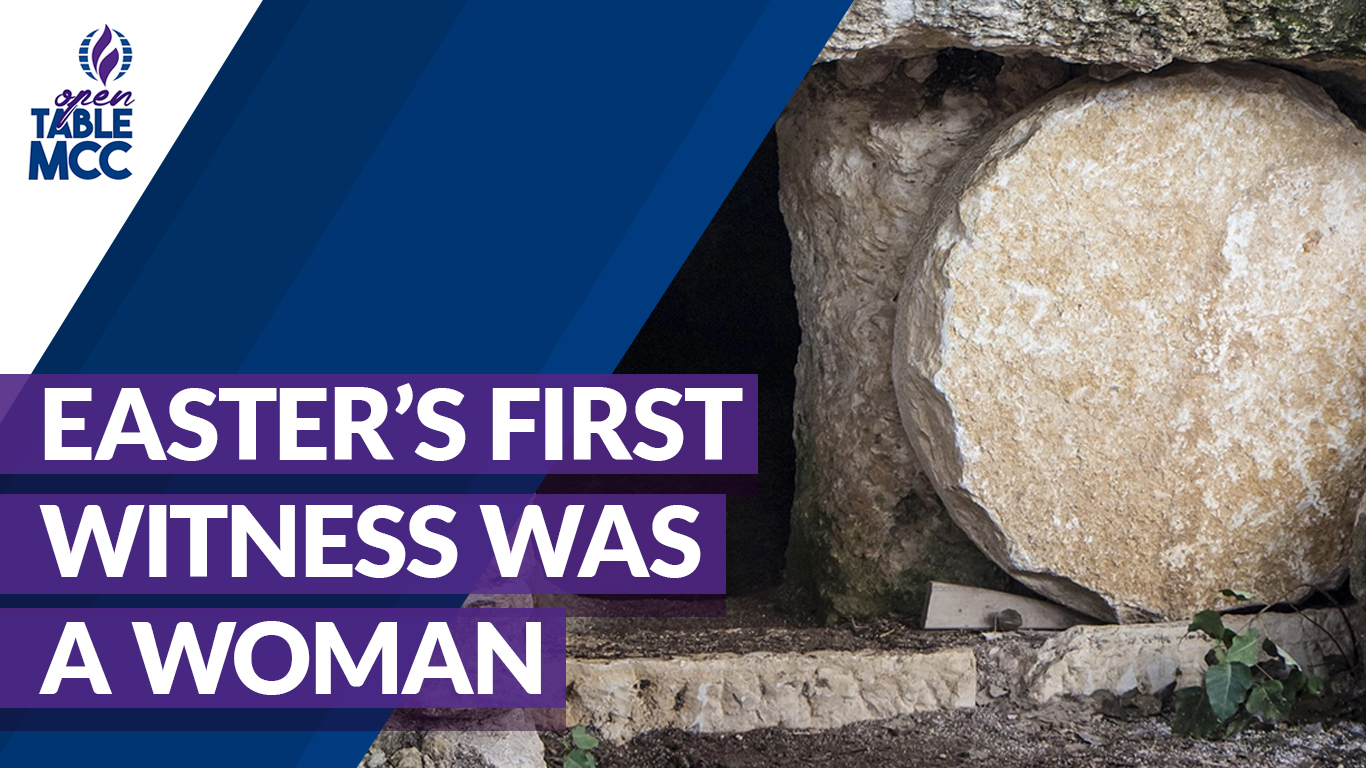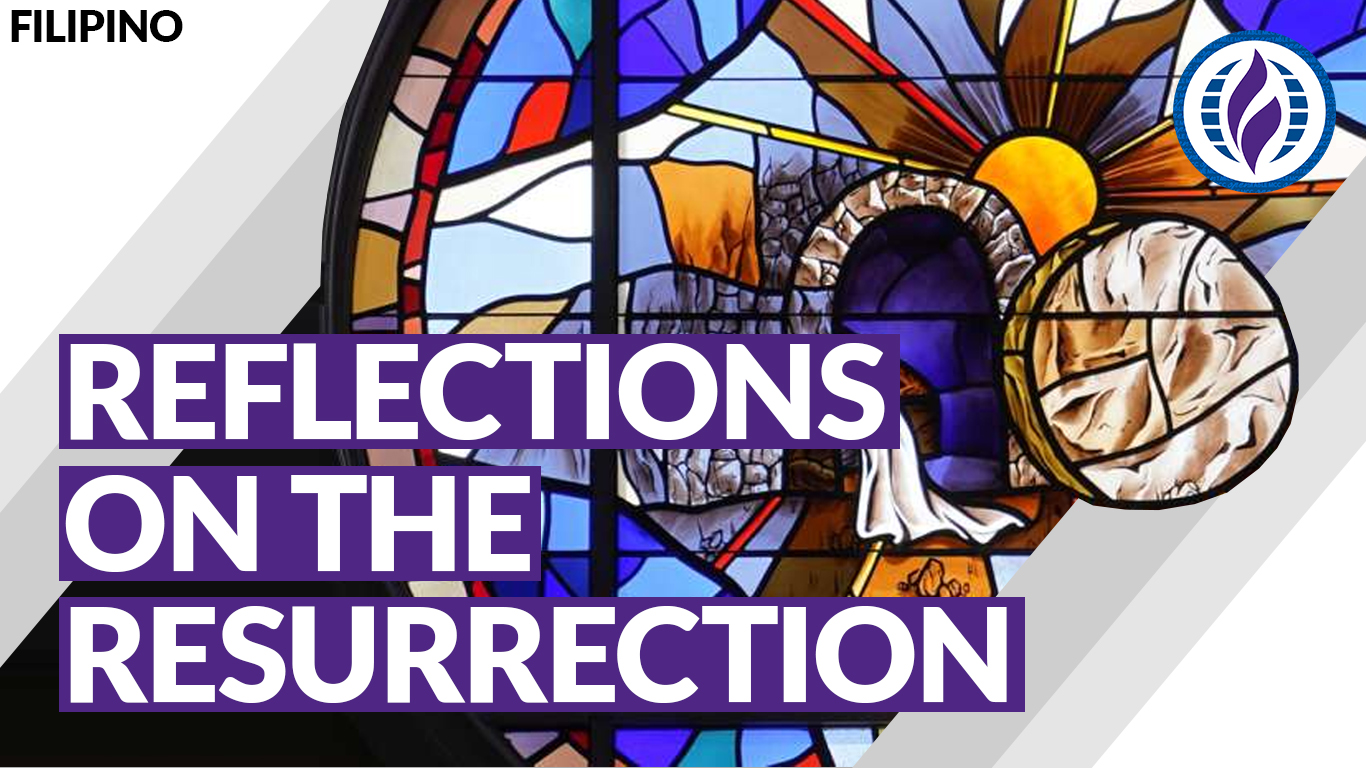Early on the first day of the week, while it was still dark, Mary Magdalene came to the tomb and saw that the stone had been removed from the tomb. So she ran and went to Simon Peter and the other disciple, the one whom Jesus loved, and said to them, “They have taken the Lord out of the tomb, and we do not know where they have laid him.” Then Peter and the other disciple set out and went toward the tomb. The two were running together, but the other disciple outran Peter and reached the tomb first. He bent down to look in and saw the linen wrappings lying there, but he did not go in. Then Simon Peter came, following him, and went into the tomb. He saw the linen wrappings lying there, and the cloth that had been on Jesus’s head, not lying with the linen wrappings but rolled up in a place by itself. Then the other disciple, who reached the tomb first, also went in, and he saw and believed, for as yet they did not understand the scripture, that he must rise from the dead. Then the disciples returned to their homes.
But Mary stood weeping outside the tomb. As she wept, she bent over to look into the tomb, and she saw two angels in white sitting where the body of Jesus had been lying, one at the head and the other at the feet. They said to her, “Woman, why are you weeping?” She said to them, “They have taken away my Lord, and I do not know where they have laid him.” When she had said this, she turned around and saw Jesus standing there, but she did not know that it was Jesus. Jesus said to her, “Woman, why are you weeping? Whom are you looking for?” Supposing him to be the gardener, she said to him, “Sir, if you have carried him away, tell me where you have laid him, and I will take him away.” Jesus said to her, “Mary!” She turned and said to him in Hebrew, “Rabbouni!” (which means Teacher). Jesus said to her, “Do not touch me, because I have not yet ascended to the Father. But go to my brothers and say to them, ‘I am ascending to my Father and your Father, to my God and your God.’ ” Mary Magdalene went and announced to the disciples, “I have seen the Lord,” and she told them that he had said these things to her.
John 20:1-18 NRSVUE
Happy Easter!
The theme for the season of Easter is “The Gift of Surprise: The Joy of the Unexpected.” In the following weeks, we will be using passages from the Vanderbilt lectionary. And, for the next few weeks, we will be reading from the Gospel of John.
Life is so playful. Una, ito ba naman ang tema natin. When the theme was given by Pastor Joseph, I was surprised. Una, dahil ayoko ng surprises. I’m a black and white person. I think it lies in my nature as a perfectionist (or as a control freak). I want to know the details so I can plan and that I will not be disappointed. In my mind was an endless simulation of situations, and I tend to imagine the worst things that might happen to prepare for a gameplan in my head. Madalas, sasabihin ko na lang na “Nakita ko na ‘yan.” The “foresight” is a product of “tragedies” being replayed and solved in my head. Kaya, “joy of the unexpected?” No, I do not find joy in not knowing.
(Also, mukha ba akong joyful?)
Pangalawa, andaming surprises ng mga araw bago ang Linggong ito. Health scare, some dilemmas, and other things. I was not even sure if I can even stand before you today and, as I was writing this intro, alam kong hindi ako tatayo ngayong Linggo para basahin ito. I am fully convinced that it is only by grace that I can make it this day (be it physically or in spirit).
Can I get an amen?
Background:
The Gospel of John is surprising. It is strikingly different from the other three gospels: from the structure, the theme, its theology, the materials it contains like the Signs (or miracles), even how Jesus was presented. Medyo iba ang gospel of John from Mark, Luke, and Matthew. Jesus was described in the Synoptic Gospels as “the witness of faith,” prodding his listeners, his disciples to believe in God. In John, he became “the object of faith.” Along with other literary elements in the Gospel of John like the logos and pre-existence introduction, another key material which transformed Jesus from being a mere moral teacher to a god, presenting in the gospel a “high” and advanced Christology, is the narrative of the resurrection. Just a review from our boot camp – this means that each of the gospels to some extent mirror and reflect how the early Christians were trying to make sense of their faith in relation to Jesus of Nazareth, who for them is the promised Messiah. Each of the gospel tries to answer the question of Jesus about Jesus – “Who do you say I am?”
The Resurrection:
In the opening of the resurrection story in the Gospel of John, a character so dear to us was the first on the scene—Mary of Magdala, the tower, the disciple of Jesus. It was still dark, and she was already at the tomb, the place that they never thought Jesus would be at.
A week ago, they were shouting “Hosanna!” in protest lines. They were hopeful because Jesus may be the political messiah they were waiting for. They bet that he might be unlike the others before him. He promised and proclaimed to those under Roman occupation “release to the captives, sight to the blind, freedom to those who are oppressed.” He also proclaimed a kingdom not like that of the Empire.
But, surprise, he ended up the same – killed by those in power.
They cannot believe it. It was unlike anything they imagined. They were even arguing who would sit beside him once his kingdom has been established. (Of course he reprimanded them.) They thought they were set to win.
But the Empire has its ways. It uses, twists, co-ops, or threatens other institutions to their advantage. The Temple institution, threatened by Jesus and his teachings, was instrumental; they called him a blasphemer, a rebel, and an instigator of the people. Most of those in the halls of power didn’t want any reform nor their leadership and teachings questioned. They wanted their “legacy of service” continued. They can sway people who welcomed Jesus with cheers of “Hosanna to the Son of David” to shout “Crucify him!” next.
The empire, those in power, determined his death. It led Jesus to that hill, hanging on the cross with his fellow criminals. It caused his disciples to scatter and tremble in fear. It led Mary in that dark, cold, gloomy morning in the tomb where he was laid down.
Now, where is the good kind of surprise in this story? Where is the joy in this unexpected event? Was it even “unexpected” when, as always, the empire wins? Let us go back to the first of four appearance stories of Jesus in the Gospel of John.
Recognize the divine.
John’s account of Easter starts with the empty tomb (20:1–10), just like Matthew, Mark, and Luke, although it is told very differently. Only one woman, Mary Magdalene, is named instead of several. Although she does not enter the tomb, and she “saw (βλέπει; blepei) that the stone had been removed from the tomb.” The Gospel writer said that Mary Magdalene brings Peter and the beloved disciple, who dash to the tomb, open it, discover it empty but for the burial wrappings, and then head back “to their homes.”
Mary Magdalene was left crying at the tomb. Then she peered in, looked closely and saw (θεωρεῖ; theōrei) two angels who asked, “Woman, why are you crying?” She was not merely seeing, she contemplated, observed, scrutinized (theorei) the scene. She responds, “They have taken away my Lord, and I do not know where they have laid him.” Neither Mary nor the two disciples understood what the empty tomb meant.
When she had said this, she turned around and saw Jesus standing there, but she did not know that it was Jesus. She does not recognize him. Instead, she thinks he is the gardener and says to him, “Sir, if you have carried him away, tell me where you have laid him, and I will take him away.” Jesus calls her by name, “Mary,” and she recognizes him. She exclaimed “Rabbouni!” (Teacher! Lord!). Later, she was sent to the other disciples and said, “I have seen (ἑώρακα; heōraka) the Lord.”
One of the key features of the Gospel of John is what theologians called “progressive revelation.” The Gospel writer/s were good in building up the story and eventually revealing something at the end. This may not be noticeable for those who cannot read/understand the Koine Greek. In the story of Mary Magdalene in the first Easter, this can be seen with the word choices of the author. We have only read the verb “see/have seen” but the original language reveals more.
From (blepei) “looking in” or “to clearly see a material object” (referring to the stone removed from the tomb) in verse 1, Mary then became more observant (theorei) in verses 12 and 14 (the ancient Greek word theorei means “to contemplate, observe, scrutinize”). Eventually, she came to (heoraka, like eureka) have found, and recognized Jesus.
So, look closely, contemplate, and find God in the details of our lives and in our his/herstory. May we find not just the stone rolled away, or the burial cloths lying; may we recognize that Jesus is alive and experience God in as we seek. Recognize divine moments in our mundane lives. The key is that we seek.
Let yourself be surprised with how God moves.
The death of Jesus was a surprise to them because they already had something in their mind of what his earthly kingdom will be. So, when he died, their world crashed.
Actually, it shouldn’t even come as a surprise because the gospels themselves tell us that Jesus himself told his followers that he would die and that he would rise again. But the thing with us followers, we are so caught up with our own imaginations of how things should be, and even how God should be, that we do not pay attention to what God or Jesus is telling us. And when what is being told finally happens, we are shocked and surprised.
For example, our country and world are such a terrible place right now. A lot of shit is happening. We have tyrannical leaders rising to power once more. We are threatened again on the edge of the possibility of World War III. Destructive climate change. The current political in-fighting of Team Kadiliman and Team Kasamaan; and now sumama na rin ang Team Kaitiman. And we can be so caught up and distracted with all these terrible things. We can focus on despair and hopelessness that we forget the lessons of human history and the promise of our own faith – tyrants, empires, and evil powers do not have the final say on things. Good will always rise. And though it might be long, as Martin Luther King Jr. said, the moral arch of the universe bends ever towards justice.
God was not done yet. God never is.
In the absurdity of life, the handiwork of the divine is very evident in the stories of humankind. In Egypt, the Habiru (Hebrew) were enslaved for generations. YHWH liberated them from the shackles of slavery. The God of the Bible took the side of the oppressed. God revealed to the prophets that it is them who frees nations under the rule of empires. Our God is the God who declares that justice will roll down like water and righteousness like an ever-flowing stream. We must only be patient. We only must know the signs of the time. God is moving in ways we cannot see, we only have to do our part.
The morning of March 11 was ordinary when rumors of Duterte’s arrest was sent to our group chat with the nanay’s of Payatas. Volunteers kami ni Jeb sa Project SOW (Solidarity with Orphans and Widows), mga left-behind, mga biktima ng tokhang. Hindi pa kami naniniwalang mag-asawa noong una. Paano ba naman, yung mga sanggol na kinakarga-karga namin dati, nasa eskwelahan na. Baka excited lang si Fr. Bong, sabi ko sa isip ko. Pero nung sinabing naisyuhan na sya ng warrant at in detention na, naiyak na lang ako.
For years, we have seen the children of SOW in Payatas struggled as they were labeled as mga anak ng adik, mga anak ng natokhang. For years, we have witnessed them trying their hardest to make ends meet, striving to be productive and redeeming their names. (Trivia lang: sila ay isa sa mga supplier/producer ng PPE ng Office ng dating VP Leni noong kasagsagan ng pandemya.)
This Easter, they have been vindicated. They were victims of violence. Justice has not been fully rendered yet. Our courts have not heard their cases. But their faces that afternoon of March 11, told us that the light of resurrection dawns in their lives.
Two things were affirmed in the resurrection story. First, that Jesus lives. Second, that God has vindicated Jesus. Scripture tells us “He whom you have killed by hanging him on a tree, God exalted him on his right hand” (Acts 5: 30 -31). The Catechism of the Catholic Church says this: “The Father’s power ‘raised up’ Christ his Son and by doing so perfectly introduced his Son’s humanity, including his body, into the Trinity. Jesus is conclusively revealed as ‘Son of God in power according to the Spirit of holiness by his Resurrection from the dead’. St. Paul insists on the manifestation of God’s power through the working of the Spirit who gave life to Jesus’ dead humanity and called it to the glorious state of Lordship.” (CCC 648).
God has said “yes” to Jesus and “no” to the powers who executed him. Easter is not about an afterlife or about happy endings. Easter is God’s “yes” to Jesus against the powers who killed him. The stories underline this in different ways. In Luke and John, the risen Jesus continues to bear the wounds of the empire that executed him. In Matthew, the risen Jesus has been given authority over all the authorities of this world. Mark, writing most concisely among the authors of the gospels, says simply, “You are looking for Jesus of Nazareth, who was crucified; he has been raised.”
The authors of the gospels do not speak about Jesus’s resurrection without speaking about his crucifixion by the collusion between collaborators and imperial power. In the words of the earliest and most widespread post-Easter affirmation about Jesus in the New Testament, Jesus is Lord. And if Jesus is Lord, the lords of this world are not. Easter affirms that the domination systems of this world are not of God and that they do not have the final word.
Let joy fuel you.
Why is this important? Para sa mga biktima ng karahasan, tulad ng mga naulila at mga balo ng Payatas, ang muling nabuhay na Panginoon ay nagiging tanda ng pag-asa na balang araw, igagawad din ng Diyos ang katarungan para sa kanila. Para sa atin. Para sa iba pang mga oppressed na sektor. Kung nagawa ito ng Diyos para kay Hesus, balang araw, sa kung anong paraan at sa kung anong lugar, igagawad din ng Diyos ang tagumpay sa kanila, sa atin.
When I looked at their faces that March 11, I saw not just courage and hope. I saw joy. “Ate Rix, nakaisang hakbang tayo,” sabi ng isang nanay sa amin noong nakaraan habang nakangiti. Syempre naiyak ako. Maybe, what the psalmist sang was true, Weeping may linger for the night, but joy comes with the morning.
Joy is the sum of that hope of what has God had planned. It is that we received after much waiting, much anticipation. “It is (…) always a desire for something longer ago or further away or still ‘about to be’,” says C.S. Lewis in his autobiography. Joy sustains us enough to live with hope in these dark days we are living in.
Hindi pa tapos ang laban, alam natin yun. Our enemies are progressing also. Wala pang trial sa ICC. May eleksyon pa tayong babakahin. The situation in the United States will surely trickle down to us. The genocide in Palestine is still on going. The Roman Empire did not end when Jesus rose from the dead. But may the resurrection remind us to not live in gloom and in negativity, never appreciating even the slightest victory we can have. Jesus is Christus Victor, the one who triumphed.
May the resurrection dawn on us all. May we let God surprise us. May we find joy in the unexpected. May the God who vindicated Jesus may fully come to vindicate us and all of those who suffer around us.
Happy Easter to all!
Podcast: Play in new window | Download
Subscribe: Apple Podcasts | Spotify | RSS



